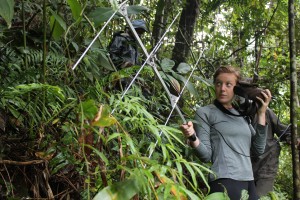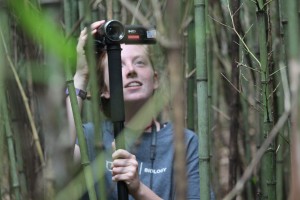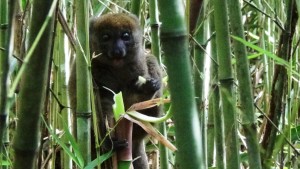July 3, 2014 – Duke students Faye Goodwin and Kyle Smith have begun their last month in Madagascar as part of a two-month service learning project funded by Duke Engage. In today’s post, Faye explains why finding and ID’ing lemurs in the rainforest for research is trickier than it sounds:
What have I learned since the last time I wrote? Collecting data on animals has a lot to do with, well, poop and genitals. Our last week has been spent trying to recognize and identify individuals within our group of bamboo lemurs in Antanetiambo Nature Reserve, which requires first of all that we can identify sex pretty quickly. Though this seemed nearly impossible when we watched a group of bamboo lemurs in Marojejy National Park, I’m pleased to report that my ability to tell males from females is now pretty quick-draw. The western lesser bamboo lemur (Hapalemur occidentalis) is a generally monomorphic species, so there is little to no color or size difference between males and females. All our identification had to come from recognizing genitalia, which it turns out is pretty distinct! Our group consists of two males and one female.
Our days start by finding the lemurs – a task that is much easier now with the new tracker, Daniel — and following them all day, taking GPS and behavioral data points on what the animals are doing and what plants they are eating during the day. This data collection will continue after we leave Madagascar, so our work with Jackson, who will be collecting the data through December, is a great way to lay down a systematic data collection method. Jackson will take down points along with us so we can compare results and make sure we are in agreement with the method of observation, while one of us will search with another guide for any additional groups of lemurs besides the three we have found most often. We will also begin collecting fecal samples to send to Cornell University and the Duke Lemur Center to be tested for parasites.

Duke student Faye Goodwin uses radio equipment to track hibernating dwarf lemurs in Marojejy National Park, Madagascar.
While finding the bamboo lemurs in Antanetiambo is pretty easy, some lemurs are not so easy to find! We recently journeyed back to Marojejy National Park to help out Marina Blanco, Ph.D, who is studying the dwarf lemurs around Camp 2. Dwarf lemurs hibernate at this time of year. The three dwarf lemurs she has been working with have radio collars, so our job was to track down the sleeping lemurs as best we could using the radio receiver to make sure all the apparatuses were still working. What an amazing experience! We learned to use the equipment and with the help of Marina’s team members Denotien and Dez Kelly, we were able to pin down roughly where the animals were. Dwarf lemurs tend to sleep in tree holes or burrowed in the ground, so it wasn’t possible for us to actually see the animals. Hopefully our work helps Marina in the future!
Not only are we learning about field research methods like radio collars, animal identification and fecal collection, we always continue to learn more about the Malagasy culture. Luckily, we got to be here for Madagascar’s Independence Day. Madagascar claimed independence from France June 26, 1957, though the celebration lasts at least three days leading up to the anniversary. We all took the day off and visited a new friend, Arianna, in the town of Andapa. Arianna is a Peace Corps volunteer in Andapa and teaches English classes. For Independence Day, many English language clubs from the SAVA region were congregating in Andapa to celebrate. It was a great few days for us as we got to meet and speak with students from all over the SAVA region, discussing conservation, Malagasy culture, and the importance of education and learning English in an eco-tourism region. Independence day itself was a whole lot of fun—all the schools were in a parade, there was music and a talent show that the students put on in the evening; there were fireworks and speeches and the carnival-like “podium” which included rows of booths with food and games. It sure was a fun break, and a great way to soak up Malagasy spirit.
I can’t believe it’s already our last month here, but we have been lucky to help with such a variety of projects and learn so many different skills. Our last month will be full-on bamboo lemur inundation, laying a strong methodological foundation for continued data collection with our great team. It’s beginning to dawn on me how many new friends I’m going to miss when I leave, but at the same time our own Independence Day tomorrow is making me think of home. Mainly, how will I give up eating rice three times a day??
Till next time—!
 Faye is a junior at Duke University and a docent at Lemur Landing. She’s studying environmental science and performance art, and spends her free time onstage, at the Duke Lemur Center, or baking goodies.
Faye is a junior at Duke University and a docent at Lemur Landing. She’s studying environmental science and performance art, and spends her free time onstage, at the Duke Lemur Center, or baking goodies.
The majority of SAVA Conservation’s project support comes from people like you! If you’d like to help the multi-faceted conservation work the Duke Lemur Center is doing on the ground in Madagascar, please visit our donate page and designate your donation to “SAVA Conservation.”



